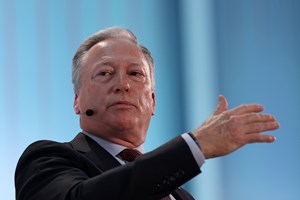Global oil demand may exceed 110 MMbpd by 2050, Enbridge CEO predicts
(Bloomberg) – Enbridge Inc. Chief Executive Officer Greg Ebel said oil demand may continue to grow in the decades ahead, putting his company’s internal assumptions among the more bullish forecasters of long-term crude usage.

Oil demand by 2050 will be “well north” of 100 MMbpd and possibly exceed 110 MMbpd, Ebel said Tuesday in an interview at Bloomberg’s New York headquarters. That contrasts with an International Energy Agency projection that demand will decline to 97 MMbpd by mid-century.
“You continue to see economic demands, and particularly in the developing world, people continue to say lighter, faster, denser, cheaper energy works for our people,” Ebel said. “And that’s leading to more oil usage.”
Enbridge’s forecast is roughly in line with a projection of 116 MMbpd by 2045 from the Organization of the Petroleum Exporting Countries. Both forecasts exceed the dramatic reductions in oil usage that modelers have said will be necessary to avoid the worst effects of global warming.
Still, Ebel said he “just can’t see a situation where” oil demand slips to 80 MMbpd or less. The world currently uses about 102.9 MMbpd, according to U.S. government figures.
The future of oil demand is a critical question for Enbridge, a pipeline behemoth that transports 30% of the crude produced in North America. Even after billions of dollars of acquisitions that diversified Enbridge’s business over the past decade — including the $28 billion takeover of natural gas transporter Spectra Energy Corp. in 2017 that brought Ebel into Enbridge — the company still generates about half its earnings from its liquids pipelines business.
Enbridge continues to invest in that division, adding storage and loading capacity at its Ingleside crude export terminal in Texas. That’s a bet that production from the Permian basin in Texas will grow by 1 to 2 MMbpd through the end of the decade. Ingleside is the largest U.S. oil-export terminal and is setting volume records “every month,” Ebel said.
“The future of oil in North America is through it and out of it,” Ebel, 60, said. “You see that on the export side.”
North America also has a role to play in the growing market for liquefied natural gas, which is increasingly in demand as Europe seeks to wean itself off Russian supplies and Asia works to limit its coal-fired electricity generation. Enbridge is connected to about 15% of U.S. Gulf Coast LNG export capacity and seeks to double that to 30% by 2030.
“Think about where we’ve come as a country in North America and the geopolitical power of that,” Ebel said. “We went from virtually not shipping anything offshore to now being No. 1 in LNG in a business that didn’t exist 15 years ago.”


